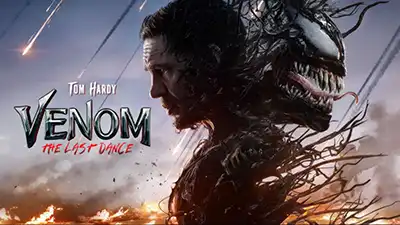Venom: The Last Dance — A Bittersweet Farewell to Cinema’s Most Chaotic Bromance
When Venom: The Last Dance was announced as the final chapter in Sony’s antihero-centric trilogy, fans braced themselves for a high-stakes, emotionally charged conclusion to Eddie Brock (Tom Hardy) and Venom’s symbiotic saga. Directed by Kelly Marcel (who also co-wrote the script with Hardy), the film promised to deliver explosive action, dark humor, and a poignant send-off for the duo that redefined the “odd couple” trope in superhero cinema. While The Last Dance stumbles in its narrative ambition, it ultimately succeeds as a flawed yet heartfelt ode to one of modern cinema’s most unconventional partnerships.
Plot Overview: A Symphony of Chaos and Sacrifice
The film opens with Eddie and Venom on the run, hunted by both a shadowy U.S. government task force led by Colonel Rex Strickland (Stephen Graham) and an extraterrestrial threat: the "Abyss Feeders", ravenous creatures dispatched by Knull, the god of symbiotes (voiced by an uncredited actor). Knull, imprisoned eons ago, seeks to reclaim the "Codex," a metaphysical bond created when Venom resurrected Eddie in the first film. This Codex serves as the key to Knull’s freedom, forcing Eddie and Venom into a globe-trotting survival mission that culminates in a fiery showdown at Area 5137.
The plot’s emotional core revolves around Eddie’s growing acceptance of his symbiotic fate. No longer the reluctant host, he embraces Venom as an irreplaceable partner, even as their banter retains its signature snark (“You’re like a bad roommate who won’t stop eating my cereal—and people’s heads”). Their dynamic peaks during a surreal detour to a Las Vegas casino, where Venom, temporarily morphing into a tuxedo-clad alter ego, declares, “I won a ‘Sexiest Man Alive’ award once!”—a meta-joke nodding to Hardy’s real-life 2012 title311.
Characters: Love, Loss, and Lobster-Clawed Villains
Eddie & Venom: Hardy’s dual performance remains the film’s anchor. Eddie’s gruff exterior softens as he grapples with mortality, while Venom’s childlike curiosity (“Why do humans wear shoes? They’re just foot prisons!”) contrasts with his ferocity. Their bond evolves from co-dependency to genuine camaraderie, culminating in a tear-jerking sacrifice sequence where Venom shields Eddie from a corrosive acid explosion, whispering, “You’re my favorite host… and my only friend”311.
Dr. Tess Payne (Juno Temple): The film’s most intriguing addition, Payne is a morally ambiguous geneticist obsessed with symbiotes. Her backstory—haunted by her brother’s death—drives her to experiment on captured, including Patrick Mulligan (a returning Stephen Graham), now bonded to the symbiote Toxin. Temple’s portrayal oscillates between cold rationality and manic obsession, particularly in a chilling scene where she merges with a purple symbiote to save her colleague, Christmas Tree Lady (a nickname coined by fans for her festive lab attire)311.
The Martin Family: A divisive subplot involves Martin (Clark Backus), a conspiracy theorist who drags his family into Eddie’s fugitive journey. While their inclusion feels narratively forced—serving mostly to humanize Venom’s desire for domesticity—their campy roadside sing-along to “I Will Survive” offers a rare moment of levity39.
Themes: Sacrifice and the Illusion of Control
The Last Dance wrestles with themes of legacy and self-determination. Venom, initially a parasitic invader, becomes a reluctant hero, questioning whether his existence is defined by Knull’s design or his own choices. This existential crisis mirrors Eddie’s arc: a man who spent years running from responsibility now confronts the ultimate act of agency—letting go710.
The film’s title takes on multiple meanings: a literal dance between Eddie and Mrs. Chen (a returning Peggy Lu) in a neon-lit casino, and a metaphorical “dance” with fate. Director Marcel frames their final battle against the Abyss Feeders as a macabre ballet, with Venom’s tendrils slicing through enemies in slow-motion—a visual nod to Spider-Verse’s fluidity, albeit with less polish39.
The Antihero Paradox: Why Venom Resonates
Venom’s appeal lies in his duality: he’s a monster who loves chocolate, a protector who eats bad guys’ heads. The Last Dance sharpens this contradiction, framing his relationship with Eddie as a metaphor for addiction and codependency. In one scene, Venom admits, “I used to think hosts were disposable… but you’re my addiction.” It’s a raw, almost romantic confession that elevates their bond beyond quippy banter310.
This complexity extends to Dr. Tess Payne, whose obsession with symbiotes mirrors Western imperialism’s extractive mindset. Her lab, filled with captive共生体, evokes real-world debates about exploitation—a bold thematic choice for a blockbuster711.

Cultural Impact: A Love Letter to Misfits
Beyond its flaws, The Last Dance resonates as a tribute to outsiders. Eddie, a disgraced journalist; Venom, a misunderstood alien; even the Martins, a family of eccentric nomads—they’re all societal rejects who find belonging in each other. The film’s most touching moment isn’t a battle cry but a quiet exchange between Eddie and a young Martin son: “Being different isn’t a curse. It’s what makes you… you”35.
The Future of the Symbiote Saga
While the post-credits scenes hint at a cockroach-powered revival, The Last Dance works best as a closed loop. Eddie and Venom’s journey—from adversarial roommates to soulmates—feels complete, their sacrifice echoing Logan’s bittersweet finale. In an era of endless franchises, there’s beauty in letting stories end37.